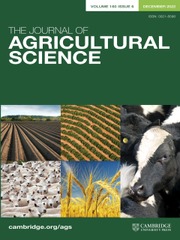Crossref Citations
This article has been cited by the following publications. This list is generated based on data provided by
Crossref.
Jensen, Erik Steen
and
Hauggaard-Nielsen, Henrik
2003.
How can increased use of biological N2 fixation in agriculture benefit the environment?.
Plant and Soil,
Vol. 252,
Issue. 1,
p.
177.
Bol, Roland
Petersen, Søren O.
Christofides, Calliopi
Dittert, Klaus
and
Hansen, Martin N.
2004.
Short‐term N2O, CO2, NH3 fluxes, and N/C transfers in a Danish grass‐clover pasture after simulated urine deposition in autumn.
Journal of Plant Nutrition and Soil Science,
Vol. 167,
Issue. 5,
p.
568.
Hansen, J.P.
Eriksen, J.
and
Jensen, L.S.
2005.
Residual nitrogen effect of a dairy crop rotation as influenced by grass-clover ley management, manure type and age.
Soil Use and Management,
Vol. 21,
Issue. 3,
p.
278.
Berntsen, J.
Petersen, B.M.
Olesen, J.E.
Eriksen, J.
and
Søegaard, K.
2005.
Simulation of residual effects and nitrate leaching after incorporation of different ley types.
European Journal of Agronomy,
Vol. 23,
Issue. 3,
p.
290.
Watson, C.A.
Öborn, I.
Eriksen, J.
and
Edwards, A.C.
2005.
Perspectives on nutrient management in mixed farming systems.
Soil Use and Management,
Vol. 21,
Issue. s1,
p.
132.
Ambus, Per
2005.
Relationship Between Gross Nitrogen Cycling and Nitrous Oxide Emissionin Grass-clover Pasture.
Nutrient Cycling in Agroecosystems,
Vol. 72,
Issue. 2,
p.
189.
Watson, C.A.
Öborn, I.
Eriksen, J.
and
Edwards, A.C.
2005.
Perspectives on nutrient management in mixed farming systems.
Soil Use and Management,
Vol. 21,
Issue. 1,
p.
132.
Berntsen, J.
Grant, R.
Olesen, J. E.
Kristensen, I. S.
Vinther, F. P.
Mølgaard, J. P.
and
Petersen, B. M.
2006.
Nitrogen cycling in organic farming systems with rotational grass–clover and arable crops.
Soil Use and Management,
Vol. 22,
Issue. 2,
p.
197.
Eriksen, J.
Pedersen, L.
and
Jørgensen, J.R.
2006.
Nitrate leaching and bread-making quality of spring wheat following cultivation of different grasslands.
Agriculture, Ecosystems & Environment,
Vol. 116,
Issue. 3-4,
p.
165.
Verloop, J.
Boumans, L. J. M.
van Keulen, H.
Oenema, J.
Hilhorst, G. J.
Aarts, H. F. M.
and
Sebek, L. B. J.
2006.
Reducing Nitrate Leaching to Groundwater in an Intensive Dairy Farming System.
Nutrient Cycling in Agroecosystems,
Vol. 74,
Issue. 1,
p.
59.
Petersen, Søren O.
Regina, Kristiina
Pöllinger, Alfred
Rigler, Elisabeth
Valli, Laura
Yamulki, Sirwan
Esala, Martti
Fabbri, Claudio
Syväsalo, Eija
and
Vinther, Finn P.
2006.
Nitrous oxide emissions from organic and conventional crop rotations in five European countries.
Agriculture, Ecosystems & Environment,
Vol. 112,
Issue. 2-3,
p.
200.
Vinther, Finn P.
Hansen, Elly M.
and
Eriksen, Jørgen
2006.
Leaching of soil organic carbon and nitrogen in sandy soils after cultivating grass-clover swards.
Biology and Fertility of Soils,
Vol. 43,
Issue. 1,
p.
12.
Thorsted, Marian D.
Olesen, Jørgen E.
and
Weiner, Jacob
2006.
Mechanical control of clover improves nitrogen supply and growth of wheat in winter wheat/white clover intercropping.
European Journal of Agronomy,
Vol. 24,
Issue. 2,
p.
149.
Ambus, P.
Petersen, S.O.
and
Soussana, J.-F.
2007.
Short-term carbon and nitrogen cycling in urine patches assessed by combined carbon-13 and nitrogen-15 labelling.
Agriculture, Ecosystems & Environment,
Vol. 121,
Issue. 1-2,
p.
84.
Sturite, Ievina
Henriksen, Trond Maukon
and
Breland, Tor Arvid
2007.
Winter losses of nitrogen and phosphorus from Italian ryegrass, meadow fescue and white clover in a northern temperate climate.
Agriculture, Ecosystems & Environment,
Vol. 120,
Issue. 2-4,
p.
280.
Pedersen, Anders
Petersen, Bjørn M.
Eriksen, Jørgen
Hansen, Søren
and
Jensen, Lars S.
2007.
A model simulation analysis of soil nitrate concentrations—Does soil organic matter pool structure or catch crop growth parameters matter most?.
Ecological Modelling,
Vol. 205,
Issue. 1-2,
p.
209.
Saarijärvi, K.
Virkajärvi, P.
and
Heinonen‐Tanski, H.
2007.
Nitrogen leaching and herbage production on intensively managed grass and grass‐clover pastures on sandy soil in Finland.
European Journal of Soil Science,
Vol. 58,
Issue. 6,
p.
1382.
Hansen, E. M.
Eriksen, J.
and
Vinther, F. P.
2007.
Catch crop strategy and nitrate leaching following grazed grass‐clover.
Soil Use and Management,
Vol. 23,
Issue. 4,
p.
348.
Eriksen, J.
Askegaard, M.
and
Søegaard, K.
2008.
Residual effect and nitrate leaching in grass‐arable rotations: effect of grassland proportion, sward type and fertilizer history.
Soil Use and Management,
Vol. 24,
Issue. 4,
p.
373.
Kayser, Manfred
Seidel, Kirsten
Müller, Jürgen
and
Isselstein, Johannes
2008.
The effect of succeeding crop and level of N fertilization on N leaching after break-up of grassland.
European Journal of Agronomy,
Vol. 29,
Issue. 4,
p.
200.

